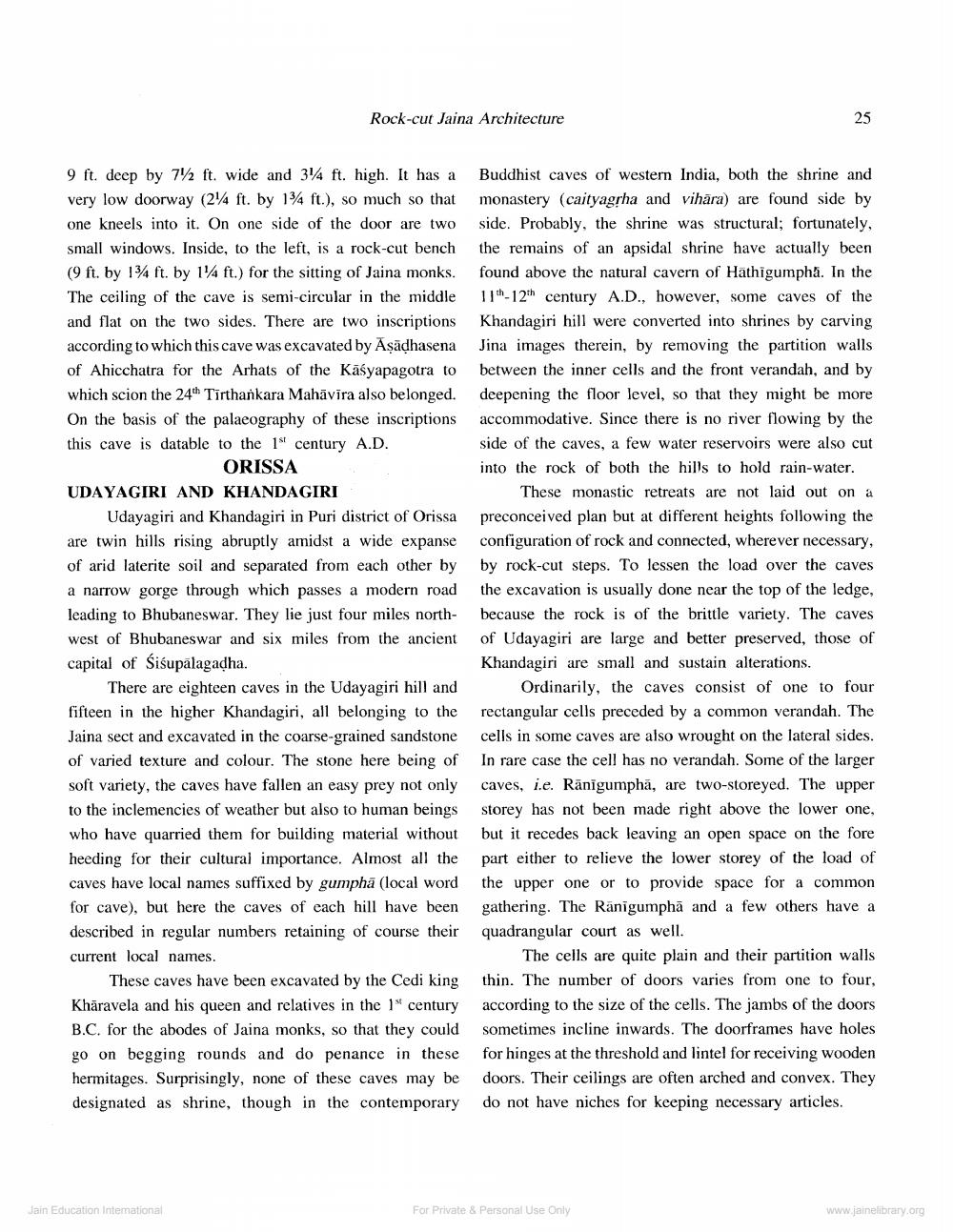________________
Rock-cut Jaina Architecture
9 ft. deep by 7% ft. wide and 3/4 ft. high. It has a very low doorway (24/4 ft. by 134 ft.), so much so that one kneels into it. On one side of the door are two small windows. Inside, to the left, is a rock-cut bench (9 ft. by 134 ft. by 114 ft.) for the sitting of Jaina monks. The ceiling of the cave is semi-circular in the middle and flat on the two sides. There are two inscriptions according to which this cave was excavated by Asādhasena of Ahicchatra for the Arhats of the Kāśyapagotra to which scion the 24th Tirthankara Mahāvīra also belonged. On the basis of the palaeography of these inscriptions this cave is datable to the 1' century A.D.
ORISSA UDAYAGIRI AND KHANDAGIRI
Udayagiri and Khandagiri in Puri district of Orissa are twin hills rising abruptly amidst a wide expanse of arid laterite soil and separated from each other by a narrow gorge through which passes a modern road leading to Bhubaneswar. They lie just four miles north- west of Bhubaneswar and six miles from the ancient capital of Śiśupālagadha.
There are eighteen caves in the Udayagiri hill and fifteen in the higher Khandagiri, all belonging to the Jaina sect and excavated in the coarse-grained sandstone of varied texture and colour. The stone here being of soft variety, the caves have fallen an easy prey not only to the inclemencies of weather but also to human beings who have quarried them for building material without heeding for their cultural importance. Almost all the caves have local names suffixed by gumphā (local word for cave), but here the caves of each hill have been described in regular numbers retaining of course their current local names.
These caves have been excavated by the Cedi king Khāravela and his queen and relatives in the 1" century B.C. for the abodes of Jaina monks, so that they could go on begging rounds and do penance in these hermitages. Surprisingly, none of these caves may be designated as shrine, though in the contemporary
Buddhist caves of western India, both the shrine and monastery (caityagrha and vihāra) are found side by side. Probably, the shrine was structural; fortunately, the remains of an apsidal shrine have actually been found above the natural cavern of Hathigumpha. In the 11th 12th century A.D., however, some caves of the Khandagiri hill were converted into shrines by carving Jina images therein, by removing the partition walls between the inner cells and the front verandah, and by deepening the floor level, so that they might be more accommodative. Since there is no river flowing by the side of the caves, a few water reservoirs were also cut into the rock of both the hills to hold rain-water.
These monastic retreats are not laid out on a preconceived plan but at different heights following the configuration of rock and connected, wherever necessary, by rock-cut steps. To lessen the load over the caves the excavation is usually done near the top of the ledge, because the rock is of the brittle variety. The caves of Udayagiri are large and better preserved, those of Khandagiri are small and sustain alterations.
Ordinarily, the caves consist of one to four rectangular cells preceded by a common verandah. The cells in some caves are also wrought on the lateral sides. In rare case the cell has no verandah. Some of the larger caves, i.e. Rānīgumphā, are two-storeyed. The upper storey has not been made right above the lower one, but it recedes back leaving an open space on the fore part either to relieve the lower storey of the load of the upper one or to provide space for a common gathering. The Ränīgumphā and a few others have a quadrangular court as well.
The cells are quite plain and their partition walls thin. The number of doors varies from one to four, according to the size of the cells. The jambs of the doors sometimes incline inwards. The doorframes have holes for hinges at the threshold and lintel for receiving wooden doors. Their ceilings are often arched and convex. They do not have niches for keeping necessary articles.
Jain Education Intemational
For Private & Personal Use Only
www.jainelibrary.org




